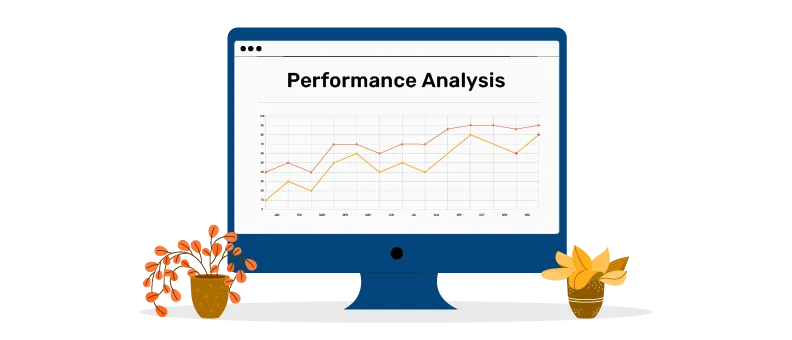An allocation to large and mid cap funds has the potential to drive significant portfolio growth over time. However, it is essential to evaluate the performance of these funds regularly to ensure that they align with your evolving life situation and the ever-changing market conditions.
In this article, we will discuss the importance to assess the performance of large and mid cap funds, the key factors to consider when evaluating returns, and how investors can use large and mid cap fund performance analysis to make informed portfolio decisions.
- Understand the analysis and returns in large and mid cap fund
- Why is it important to evaluate the performance of large and mid cap funds?
- Evaluating returns of large and mid cap funds
- Historical performance analysis of large and mid-cap funds
- How can investors use performance analysis to make informed decisions?
- Factors influencing the performance of large and mid-cap funds
- How to choose a suitable fund based on performance
Understand the analysis and returns in large and mid cap fund
Large and mid cap funds are equity funds that invest primarily in the stocks of companies with large and medium market capitalisations. These companies are ranked from 1st to 250th by market cap in India, thus they comprise the most well established and proven companies of the Indian industrial landscape. Through investment in these companies, large and mid cap funds aim to leverage the relatively stable growth potential offered by large cap stocks and the potential of substantial expansion offered by mid caps over a long horizon.
The performance of large and mid cap funds is evaluated based on their returns, which are calculated as the change in the fund's net asset value (NAV) over a specific period. The returns are usually benchmarked to a relevant index that allows for an accurate comparison of the fund performance in relation to the broader market.
Why is it important to evaluate the performance of large and mid cap funds?
Performance analysis and returns in large and mid cap funds are essential for several reasons. Evaluating performance and returns allows investors to determine whether their investments are on track to help them achieve their objectives. Secondly, investors can make informed portfolio decisions by comparing their fund’s performance against the benchmark and also with other funds. Lastly, it helps investors identify any potential risks associated with their investments.
Evaluating returns of large and mid cap funds
There are various ways to assess the performance of large and mid cap funds:
- Annualised returns: Average annual return of a fund over a specified period. It helps investors to gauge performance over time and compare it against benchmarks and peer funds.
- Benchmark comparison: Comparing fund returns against the relevant benchmark, such as BSE Large MidCap or Nifty Large MidCap 250, can facilitate an accurate assessment of performance.
- Risk-adjusted returns: Risk-adjusted returns factor in the level of risk taken by a fund to generate returns. Some tools to assess risk-adjusted returns include Sharpe ratio and Sortino ratio. A fund with higher risk-adjusted returns is preferable as it generates more returns for a similar amount of risk taken.
- Rolling returns: Assessing rolling returns can yield insights into consistency and variability in fund performance allowing investors to trends and patterns across different market conditions.
Additionally, always consider the fund expenses when computing performance as they can significantly eat into the overall returns.
Historical performance analysis of large and mid-cap funds
Data about the historical performance of mutual funds can be easily found online, including on the website of the Association of Mutual Funds of India. In general, it is advisable to look not only at 1-year returns but multiple horizons such as 3 years, 5 years and more. You can also input different start and end dates to assess performance in different market conditions. This can give a more realistic picture. And remember, past performance may or may not be sustained in the future.
How can investors use performance analysis to make informed decisions?
Investors can use performance analysis to make informed investment decisions by comparing the returns of their funds with the benchmark and other similar funds in the market. They can also use performance analysis to identify any potential risks associated with their investments. For example, if a fund has consistently underperformed its benchmark, it may indicate that the fund is not well-managed or that there are underlying risks associated with the fund's portfolio.
Factors influencing the performance of large and mid-cap funds
Several factors can significantly influence the performance of large and mid-cap funds:
Economic growth: A growing economy typically benefits both large and mid-cap companies by driving consumer spending, corporate earnings, and market optimism.
Interest rates: Rising rates can negatively affect both types of stocks, especially those with high growth expectations and valuations.
Inflation: High inflation can reduce corporate profits and increase borrowing costs, negatively impacting company performance.
Market cycles: Stock market trends, including bull and bear markets, can strongly affect the performance of both large-cap and mid-cap stocks.
Investor sentiment: Changes in investor sentiment—such as fear, greed, and risk aversion—can lead to significant market fluctuations.
Sector performance: The performance of individual sectors, such as technology, healthcare, and energy, can significantly impact fund returns.
Financial performance: Revenue growth, profitability, and financial health of companies within the fund can greatly influence returns.
Competitive landscape: Industry competition, technological changes, and shifts in consumer preferences can impact company performance and the fund's success.
Management quality: Effective leadership is essential in guiding companies through challenges and making decisions that drive long-term growth.
Investment strategy: The fund manager's approach to stock selection, risk management, and overall investment philosophy can significantly affect performance.
Portfolio construction: The fund's sector allocation, diversification, and stock weighting impact both risk and return potential.
Fund expenses: High expense ratios can reduce overall returns over time.
How to choose a suitable fund based on performance
Key factors to consider when choosing the right fund based on performance:
Past performance: Analyse the fund's historical returns over 3, 5, and 10 years. Identify funds that have shown consistent performance. Keep in mind, past performance does not guarantee future results.
Benchmark: Compare the fund's performance to that of its benchmark index.
Expense ratio: A lower expense ratio can improve long-term net returns by reducing costs.
Portfolio holdings: Review the fund’s holdings to understand its strategy and risk profile.
Conclusion
Evaluating the performance of large and mid cap funds is essential for investors who want to generate long-term wealth. By considering the key factors discussed in this article, investors can make informed investment decisions that align with their investment goals.
FAQs
How often should I evaluate the performance of my large and mid cap funds?
Investors should evaluate the performance of their large and mid cap funds at least once a year. However, it is recommended that investors evaluate their funds more frequently, such as quarterly or semi-annually.
What benchmarks should I use to compare the returns of my funds?
Investors can use broader benchmarks such as the Nifty 50, Nifty Midcap 100, or BSE 500 or more specific indices such as BSE Large MidCap or Nifty Large MidCap 250 to compare the returns of their funds.
How do I determine if a fund's performance is above or below average?
Comparing a fund’s performance against peer funds or benchmark indices can provide a standard for comparison and help investors determine whether their investment is overperforming or underperforming.
How do you analyse fund performance?
To evaluate mutual funds, compare returns to benchmarks and peers, assess risk-adjusted returns (Sharpe, Sortino ratios), and analyze the expense ratio. Consider the fund manager's experience and portfolio allocation. Evaluate performance across market cycles and ensure the fund aligns with your investment goals and risk tolerance.
Why is it important to evaluate the performance of large and mid-cap funds?
Evaluating large and mid-cap funds is vital for informed investment decisions, monitoring progress, and assessing risk. Regular evaluations enhance transparency, accountability, and alignment with financial goals.
How do you calculate the returns of large and mid-cap funds?
To calculate absolute returns, use the formula: (Current NAV−Initial NAV)/Initial NAV×100. However, this formula does not take into account the impact of time on your investment.
It is easier to look at historical performance data compiled by official sources. You can consider the Compound Annual Growth Rate (CAGR) as well as benchmark and peer comparisons and risk-adjusted returns (Sharpe and Sortino ratios). XIRR is important for calculating returns on SIPs.
What factors influence the performance of large and mid-cap funds?
The performance of large and mid-cap funds is influenced by factors such as macroeconomic conditions (economic growth, interest rates, inflation), industry trends (technology, competition, regulations), company-specific factors (financial performance, management, competitive advantage), market sentiment, and the expertise of the fund manager in stock selection and portfolio construction.
How can I compare the performance of large and mid-cap funds with benchmarks?
To compare large and mid-cap fund performance, check the performance of your scheme and then look at the benchmark returns for the same period under consideration. The scheme benchmark will be mentioned in all essential scheme-related documents. For example, for large and mid cap funds, the benchmark could be Nifty Large Midcap 250 TRI.
You can also analyze returns over different periods and calculate the alpha to measure outperformance. Consider time horizons, market cycles, and expense ratios for a comprehensive evaluation of performance.
Related Searches:
Mutual Fund investments are subject to market risks, read all scheme related documents carefully.
This document should not be treated as endorsement of the views/opinions or as investment advice. This document should not be construed as a research report or a recommendation to buy or sell any security. This document is for information purpose only and should not be construed as a promise on minimum returns or safeguard of capital. This document alone is not sufficient and should not be used for the development or implementation of an investment strategy. The recipient should note and understand that the information provided above may not contain all the material aspects relevant for making an investment decision. Investors are advised to consult their own investment advisor before making any investment decision in light of their risk appetite, investment goals and horizon. This information is subject to change without any prior notice.


